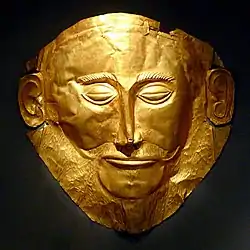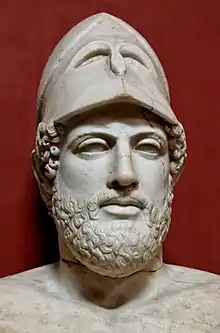الخطوط العريضة لليونان القديمة
توفر الخطوط العريضة التالية نظرة عامة ودليل موضعي لليونان القديمة:

أكروبوليس أثينا
جغرافيا اليونان القديمة
- مدن اليونان القديمة [الإنجليزية]
- قائمة مدن اليونان القديمة [الإنجليزية]
مناطق اليونان القديمة
- بيلوبونيز
- وسط اليونان
- آنيس [الإنجليزية]
- أتيكا
- بيوتيا
- دوريس [الإنجليزية]
- وابية
- لوكريس [الإنجليزية]
- ماليس [الإنجليزية]
- ماجيريس [الإنجليزية]
- أوتيتا [الإنجليزية]
- فوكيس
- أكارنانيا
- أيتوليا
- إبرنشيا [الإنجليزية]
- ديلوبيا [الإنجليزية]
- ثيساليا
- فيراي
- لاريسا
- منطقة فرعية مستقلة
- ماغنيسيا
- المناطق الفرعية داخل ثيساليا
- آخايا فثيوتيس [الإنجليزية]
- هيثستيوتيس [الإنجليزية]
- بيلسجاتوس [الإنجليزية]
- بيربيا [الإنجليزية]
- إبيروس
- مقدونيا القديمة
- Pelagonia
- بحر إيجة
- كريت
- قبرص
- البحر الأيوني
- الدردنيل
- بحر مرمرة
- البوسفور
- الأناضول
- ماجنا غراسيا
- المستعمرات الأغريقية [الإنجليزية]
الحكومة والسياسة في اليونان القديمة
- الديمقراطية اليونانية القديمة [الإنجليزية]
- المشرعون اليونانيون القدماء
- دراكو – المشرع الأول لأثينا في اليونان القديمة. وضع قانون مكتوب مكان النظام السائد من القانون الشفهي والعداء الدموي ليتم فرضه فقط من قبل المحكمة. أصبح قانون دراكو المكتوب معروفًا بقسوته، مع صفة "دراكوني - شديد القسوة" التي تشير إلى قواعد أو قوانين لا ترحم على نحو مماثل.
- الدستور الداركوني [الإنجليزية] – أول دستور مكتوب من أثينا. حتى لا يكون هناك من يجهله، تم نشره على ألواح خشبية (νεςονες-axones)، حيث تم الحفاظ به لمدة قرنين تقريبًا، على ألواح تذكارية على شكل ثلاثة أهرامات.
التاريخ العسكري لليونان القديمة
الجيش في اليونان القديمة
- الحرب في اليونانية القديمة
- هوبليت
- تشكيلة سلامية
- التكتيكات العسكرية في اليونان القديمة [الإنجليزية]
- المثلية الجنسية في القوات اليونانية القديمة [الإنجليزية]
- عتاد القوات الشخصي في اليونان القديمة [الإنجليزية]
القوات العسكرية والتحالفات والإتحادات
- الاتحاد الأيوني [الإنجليزية] (بدء أواسط القرن السابع قبل الميلاد)
- اتحاد آخاين الأول (تأسس في القرن الخامس قبل الميلاد)
- الاتحاد الديلي (478-404 ق.م)
- السيطرة الأسبرطية [الإنجليزية] (431-371 ق.م)
- السيطرة التيفية [الإنجليزية] (371-362 ق.م)
- الرابطة الكورنثية (338-322 ق.م)
- الاتحاد البيلوبونيزي (القرن السادس إلى القرن الرابع قبل الميلاد)
- الاتحاد الأركادي [الإنجليزية] (370 إلي القرن الثالث قبل الميلاد)
- اتحاد آخاين الثاني (280-146 ق.م)
- الإتحاد الأيتوليي (القرن الرابع إلي القرن الثالث قبل الميلاد)
الصراعات العسكرية
- حصار طروادة
- Trojan War characters
- حرب ليلانتين
- الحروب الميسينية
- First Messenian War
- Second Messenian War
- هيلوتس
- First Sacred War
- الحروب الفارسية اليونانية – سلسلة من الصراعات بين الإمبراطورية الأخمينية في بلاد فارس ودول المدن في العالم الهيليني (اليوناني) والتي بدأت في 499 ق.م واستمرت حتى 449 ق.م.
- الثورة الإيونية
- Battle of Lade
- معركة ماراثون
- معركة ترموبيل
- معركة سالاميس
- معركة بلاتيا
- معركة ميكالي
- Battle of the Eurymedon
- الحرب البيلوبونيزية الأولى
- Battle of Oenophyta
- Battle of Coronea (447 BC)
- Battle of Tanagra (457 BC)
- إمبراطورية قرطاجية
- الحرب البيلوبونيسية
- معركة أرغينوز
- معركة دليوم
- Battle of Chalcis
- معركة سيبوتا
- Battle of Potidaea
- Battle of Naupactus (429 BC)
- Battle of Notium
- Battle of Syme
- Battle of Cynossema
- Battle of Pylos
- Battle of Sphacteria
- Battle of Amphipolis
- معركة مانتينيا
- Battle of Olpae
- الحملة الصقلية
- Battle of Syme
- Battle of Cyzicus
- Battle of Aegospotami
- الحرب الكورنثية
- Battle of Coronea (394 BC)
- Battle of Naxos
- معركة ليوكترا
- معركة كينوسكيفالاي
- Battle of Mantinea (362 BC)
- الأناباسيس
- Battle of Cunaxa
- Battle of Crocus Field
- Foreign War

- حروب الإسكندر الأكبر
- الحرب اللمومية
- Battle of Crannon
- حروب ملوك طوائف الإسكندر
- معركة كوروبيديوم
- Battle of Crannon
- Battle of Gabiene
- Battle of Gaza (312 BC)
- معركة إبسوس
- Battle of Paraitacene
- موقعة رفح
- معركة سلاميس
- حرب الكرومنادين
- Battle of Sellasia
- Battle of Pydna
- معركة كينوسكيفالاي
- Battle of Asculum
- الحرب الكريتية (205-200 ق.م)
- الحرب المقدونية الأولى
- الحرب المقدونية الثانية
- الحرب المقدونية الثالثة
- الحرب المقدونية الرابعة
- Battle of Pydna
التاريخ العام لليونان القديمة

قناع الموت، يُعرف ب قناع أغاميمنون، القرن السادس قبل الميلاد، وربما أشهر أثر تاريخي من اليونان الموكيانية
التاريخ اليوناني القديم، بالفترة
- تاريخ يونان ما قبل التاريخ
- History of ancient Greece (الجدول الزمني لليونان القديمة)
تاريخ اليونان القديمة، بالمنطقة

Bust of Pericles, marble Roman copy after a Greek original from c. 430 BC
- تاريخ أثينا
- ديمقراطية أثينية – democracy in the أثينا الكلاسيكية developed around the fifth century BC, making Athens one of the first known democracies in the world, comprising the city of Athens and the surrounding territory of Attica. It was a system of direct democracy, in which eligible citizens voted directly on legislation and executive bills.
- سولون (c. 638 – c. 558 BC)– Athenian statesman, lawmaker, and poet. Legislated against political, economic, and moral decline in اليونان العتيقة. His reforms failed in the short term, yet he is often credited with having laid the foundations for Athenian democracy.[1][2][3][4]
- كليسثنيس (born around 570 BC). – father of Athenian democracy. He reformed the constitution of ancient Athens and set it on a democratic footing in 508/7 BC.
- Ephialtes (died 461 BC) – led the democratic revolution against the Athenian aristocracy, which exerted control through the اريوباغوس, the most powerful body in the state.[5] Ephialtes proposed a reduction of the Areopagus' powers, and the إكيلازيا (أثينا القديمة) (the Athenian Assembly) adopted Ephialtes' proposal without opposition. This reform signaled the beginning of a new era of "radical democracy" for which Athens would become famous.
- بريكليس – arguably the most prominent and influential Greek statesman. When Ephialtes was assassinated for overthrowing the elitist Council of the Aeropagus, his deputy Pericles stepped in. He was elected إستراتيجوس (one of ten such posts) in 445 BCE, which he held continuously until his death in 429 BCE, always by election of the Athenian Assembly. The period during which he led Athens, roughly from 461 to 429 BC, is known as the "Age of Pericles".
- أوستراكية – procedure under the Athenian democracy in which any citizen could be expelled from the city-state of Athens for ten years.
- اريوباغوس – council of elders of Athens, similar to the Roman Senate. Like the Senate, its membership was restricted to those who had held high public office, in this case that of أركون.[6] In 594 BC, the Areopagus agreed to hand over its functions to Solon for reform.
- إكيلازيا (أثينا القديمة) – principal assembly of the democracy of ancient Athens during its "Golden Age" (480–404 BCE). It was the popular assembly, open to all male citizens with 2 years of military service. In 594 BC, Solon allowed all Athenian citizens to participate, regardless of class, even the thetes (manual laborers).
- ديمقراطية أثينية – democracy in the أثينا الكلاسيكية developed around the fifth century BC, making Athens one of the first known democracies in the world, comprising the city of Athens and the surrounding territory of Attica. It was a system of direct democracy, in which eligible citizens voted directly on legislation and executive bills.
- History of Sparta
تاريخ اليونان القديمة، بالموضوع
- Names of the Greeks
الأعمال على تاريخ اليونان القديمة
تكنولوجيا اليونان القديمة
- هندسة اليونان القديمة
- وحدات القياس اليونانية القديمة
المراجع
- Stanton, G.R. Athenian Politics c800–500BC: A Sourcebook, Routledge, London (1990), p. 76.
- Andrews, A. Greek Society (Penguin 1967) 197
- E. Harris, A New Solution to the Riddle of the Seisachtheia, in 'The Development of the Polis in Archaic Greece', eds. L. Mitchell and P. Rhodes (Routledge 1997) 103
- Aristotle Politics 1273b 35–1274a 21.
- Fornara-Samons, Athens from Cleisthenes to Pericles, 24–25 نسخة محفوظة 28 يوليو 2020 على موقع واي باك مشين.
- Aristotle, Constitution of the Athenians, §3.
روابط خارجية
- The Canadian Museum of Civilization—Greece Secrets of the Past
- Ancient Greece website from the المتحف البريطاني
- Economic history of ancient Greece
- The Greek currency history
- Limenoscope, an ancient Greek ports database
- The Ancient Theatre Archive, Greek and Roman theatre architecture
- Illustrated Greek History—Dr. Janice Siegel, Department of Classics, Hampden-Sydney College, Virginia
- بوابة اليونان القديم
This article is issued from Wikipedia. The text is licensed under Creative Commons - Attribution - Sharealike. Additional terms may apply for the media files.

